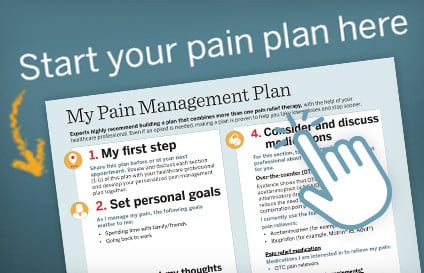Managing pain is all about finding the right balance
When you’re managing pain, like pain after surgery, it can be challenging to balance the risks and benefits of all pain management options, such as over-the-counter (OTC) pain relievers, prescription medicines, and non-drug methods. And while many patients may have concerns, not many are speaking up.
In a 2018 Mayo Clinic survey, 94% of adults surveyed said they would choose an alternative to opioids for post-surgery treatment, but only 1 in 4 have talked to their healthcare professional about alternatives.* By creating a pain management plan, you can define your pain relief goals and work with your healthcare professional on the appropriate options to reach them.

Create your pain management plan with this downloadable planner and take it to your next appointment.
Take control and make your pain management plan personal
Some proven ways to help with pain management are OTC pain relievers, prescription medicines (such as opioids), non-drug methods (such as heat therapy or electrical nerve stimulation), and alternative therapies (such as acupuncture or massage).
To make the most of your pain management plan, be sure to:
Speak up! Express your concerns with your doctor or nurse practitioner—especially if you’re worried about opioid or non-opioid pain relief options. They want to know!
Know your options. Remember, you have a say in creating your plan. Let your doctor or nurse practitioner know if you’re interested in non-drug pain relief options, too. Some pain management techniques may include cold and heat therapy, acupuncture, meditation, sleep, exercise, and massage.
Set personal goals. Make pain management goals that mean the most to you. Instead of trying to eliminate your pain completely, try to focus on getting back to your regular activities faster, such as sleeping through the night or getting back to work.
Find more information about relieving minor back pain including important questions to ask your doctor, or get tips for safe, effective headache relief.
Consider the efficacy and safe use of OTC pain relievers as part of your plan
Many studies support the efficacy of OTC pain relievers for a variety of pain states. If your healthcare professional recommends an OTC pain reliever, remember to:
Follow directions. Take your medicine exactly as your healthcare professional tells you, to stay on track for recovery. You can also download OTC dosing charts. Remember to take ONLY 1 medicine that contains the same kind of active ingredient at a time.
Get ahead of your pain. Even if you are feeling better, keep following your pain management treatment regimen.
Make a list of every medicine you take, including OTC and prescription medicines, vitamins, and herbal supplements. The medicines you are currently taking may affect which pain reliever your healthcare professional recommends.
Get started by using an easy-to-use personal downloadable planner before your next appointment. Fill it out to keep what's important top of mind.

Choose OTC pain medicines safely.
Certain OTC pain relievers may be a better choice for you than others.
*Based on Mayo Clinic National Health Checkup Survey of 1,270 adults (18 years and older) living in the US conducted in July 2018 through Engine Telephone CARAVAN Omnibus Survey.

